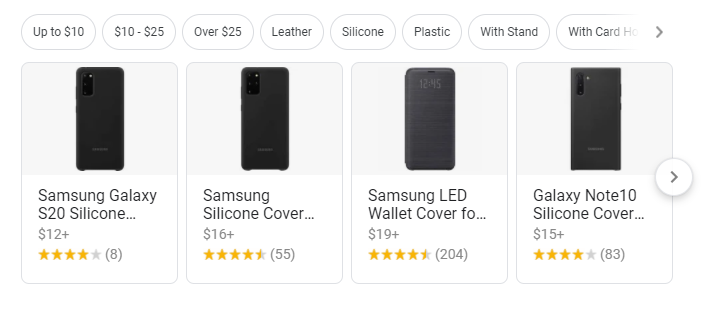Usually, visitors reach your online store by clicking on one of your links within the Search Engine Results Pages (SERPs). Once they’re in, they can decide what products to look for and if they want to make a purchase or not. That whole process is part of the customer journey and it’s something that you can’t ‘skip’, so to speak.

That is, of course, unless your inventory shows up directly on a Google Product Feed right within the SERPs. By having the items people are looking for show up directly in the results, you can capture users that are ready to make a purchase right away. Plus, you get a lot more exposure, which is always a good thing in online sales.
In this article, we’re going to talk about how the Google Product Feed works. Then we’ll go over how you can optimize your product feed to run better campaigns that get you more sales. Let’s get to work!
How the Google Product Feed Works (And Why You Should Be Using It)
The Google Product Feed is part of the search giant’s Shopping platform. With Google Shopping, you can create ads for your online store’s products instead of promoting landing pages. For example, here are some of the products that Google recommends if you look up Samsung phone cases:

Unlike ‘full’ search results, the product feed doesn’t include meta descriptions. What you get is the following:
- Product title
- One product image
- Rating and review numbers if they’re available
- Pricing information
- A link to your store
During the past years, product feed or listing ads have grown dramatically in popularity. Product feed results make up for over 80% of all clicks for Google campaigns. Product ads are quick and to the point, which is something a lot of your customers might appreciate. After all, if you already know what you want to buy and are ready to make a purchase, it’s easy enough to make a decision based around price, product images, and ratings.
On top of sponsored results in the SERPs, Google Shopping also comes with its own dedicated tab. Within the Shopping tab, discerning customers get even more options to compare products in the niches they’re researching:

Getting your online store’s products to appear on Google Product Feeds and the Shopping tab requires you to set up a Merchant Center account. We wrote a full guide on to how get started with using Google Merchant Center so give it a read. Once your products are ‘up’ and you’ve linked your Merchant Center account with Google Ads, you’re ready to rumble.

And by rumble, we mean making as many sales as you can. Go get that money!
4 Tips for Running Better Shopping Campaigns by Optimizing Your Google Product Feed
As we mentioned before, Google Shopping ads don’t include as many ‘elements’ as more traditional campaigns. That means you’re on more equal footing with other advertisers, but it also makes optimization all the more important. Let’s run through some tips to ensure you maximize your product feed’s Return on Investment (ROI).
1. Optimize Your Product Titles
Without meta descriptions, you rely almost entirely on your titles to ensure that the products you upload appear in front of the right people. Let’s say, for example, you run an online store selling running shoes. You want to increase sales for your men’s running shoes catalog, and you upload the following products to your feed:
- Men’s blue running shoes
- Men’s red gel running shoes
As product titles go, those two are very lackluster. They barely give potential buyers any useful information. Even worse, by using generic product titles, you decrease the chances that your inventory will show up on the SERPs.
Let’s take a look at some product title examples from the Shopping tab to give you an idea of what level of detail you should be aiming for:

Notice that all three results follow a similar structure. They include the brand of the shoe followed by its model. If you open any of those results, you’ll notice they also include color, size, and other identifying features. More importantly, product descriptions finally make an appearance:

To put it simply, you need to put the same level of care into product Search Engine Optimization (SEO) as you would with regular pages. That means using keywords as part of your titles and descriptions.
With products, you don’t need to make titles ‘catchy’. What you want is to provide as much information as possible and focus on including the key identifiers and features that shoppers might be looking for.
It wouldn’t be an exaggeration to say that product titles are one of the two most important elements for Google Shopping ads. Let’s find out what that second key element is.
2. Use the Right Product Images
You can’t judge a book by its cover, but you’re entirely justified in judging a product online by its images. When you’re online shopping, you can’t pick up a product to look it over, so using the ‘right’ images to show up your inventory is crucial.
On your website, you can upload as many product images as you want. However, with Google Shopping ads, users will only see one of them, so it’s essential that you choose the best one. Some quick tips to help you find that perfect shot include:
- Use a high-resolution image. It’s 2020, we don’t believe in pixelated images anymore.
- Ensure that images show off the product’s key features. Those features are probably what shoppers are looking for, so play them up.
- Remove any text or elements that obscure your images. Product images shouldn’t contain watermarks, logos, or anything else that hides what you’re selling.
Remember that unless users actually click on your product, the images they see in their product feed are rather small. That means you need to adapt to that smaller format by using images that look good and show enough details even at smaller sizes.
One quick way to help you decide what images to use is to look up similar products on the Shopping tab. The entire shoe industry, for example, has apparently decided to use the same type of images for product feeds:

In this case, the reasoning is obvious. With a full horizontal shot, you can show as many details as possible. However, not all types of products are so ‘easy’ to choose images for. If you look up sweatshirts, for example, you can see an even spread of product images using models and others that don’t:

If you’re in doubt, you can always experiment using different types of images for your product feed and see what works best for your audience. If you’ve been running your online store for a while, though, you probably already have a firm grasp on how to promote your products.
3. Flesh Out Your Product Descriptions
As we’ve mentioned before, a lot of shoppers won’t see your product descriptions in Shopping ads. However, that doesn’t mean that you can ignore them. For the shoppers that do want as much detail as possible, product descriptions can mean the difference between making a sale and missing out on it.
Let’s say, for example, you’re on the fence between these three unicorn plushies (no judgment here):

Assuming you like all three of them and they’re within a similar price range, your decision might come down to product descriptions. That first unicorn includes a warm and friendly description, but sadly, it’s sorely lacking in details:

Unicorn number two does a much better job. It gives you a bit of background on the toy and it includes key information about its fabric and colors:

Unicorn number three, on the other hand, hits you right out of the gate with discount promises and a hard sales pitch:

Out of those three options, number two is the one that comes the closes to hitting all the marks. With product descriptions, it’s important that you focus on the following:
- Keep them short. You have up to 5,000 characters to play with, but no one is going to read all of that. As a rule of thumb, keep yours around 150-200 characters.
- Include as many details as possible. With plushies, for example, you’d want to talk about fabrics, colors, texture, intended age range, special features, and more.
- Don’t focus solely on the details. Although we love seeing in-depth product details, it never hurts to give a little context on each product and who its intended audience is.
Product descriptions also give you the perfect opportunity to include further keywords beyond titles. Just as with regular meta descriptions, though, you don’t want to ‘stuff’ them. Be descriptive, ensure they read like something a human wrote, and you should be golden.
4. Set the Right Product Categories
One of the elements that matter the most when it comes to relevance in Shopping ads is product category. When you upload products to your Shopping Feed, Google enables you to set a specific category for each as well as types.
Google uses product categories alongside your product information to determine when to show items in customer’s feeds. On top of categories, you also have product types, which provide even more targeted information about each item in your feed:
Although Google Shopping can automatically assign categories to your products, it’s always a good idea to review the attribute. The more accurate your product categories are, the more likely it is that your items will show up for the right customers and searches.
One good example of why categories are so important would be sneakers. You have sneakers that are good for running and others that you probably shouldn’t sweat at all in because they’re for fashion. Although they’re both similar outwardly, those two represent different product categories. Using Google’s product category taxonomy, here are the options we’d recommend for each:
- For fashion pieces, you’d use Apparel & Accessories > Shoes.
- For exercise shoes, you may want to use the Sporting Goods > Exercise & Fitness category instead.
Beyond categories, Google Shopping also lets you add product types to items in your feed. Product types are for internal organization purposes. If you have multiple items in the Exercise & Fitness category, you can use product types to break them down.
Product types enable you to run more targeted ads and make it easier to compare campaigns. You can be as detailed as you want when it comes to product types and you’re not limited to Google Shopping’s category taxonomy.
Although manually reviewing the category for each product you upload to your feed might not sound glamorous, it’s essential to your campaign’s success. By ensuring your products show up for the right audience, you dramatically increase the chances of making more sales.
Conclusion
Getting your products to show up on the SERPs enables you to target users that are ready to make a purchase right away. With Google Shopping ads, customers can make quick purchase decisions, instead of having to browse through dozens of options or pages to find what they need.
It’s important to understand, though, you can’t just ‘throw’ items into your Google Product Feed and hope for the best. Just as always, if you want to run successful campaigns, you need to optimize them. Here’s what you should be doing:
- Optimize your product titles.
- Use the right product images.
- Flesh out your product descriptions.
- Set the right product categories.
Do you have any questions about how to optimize your Google Product Feed? Let’s go over them in the comments section below!


